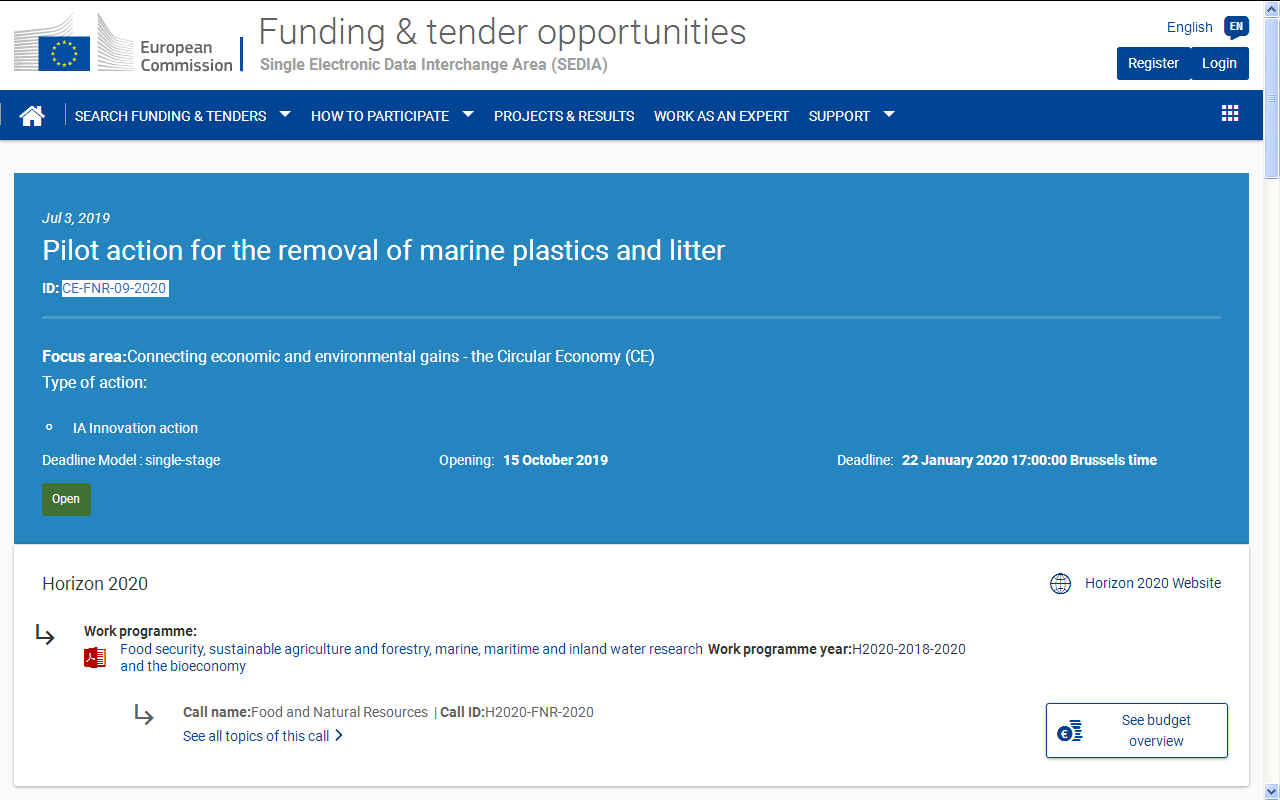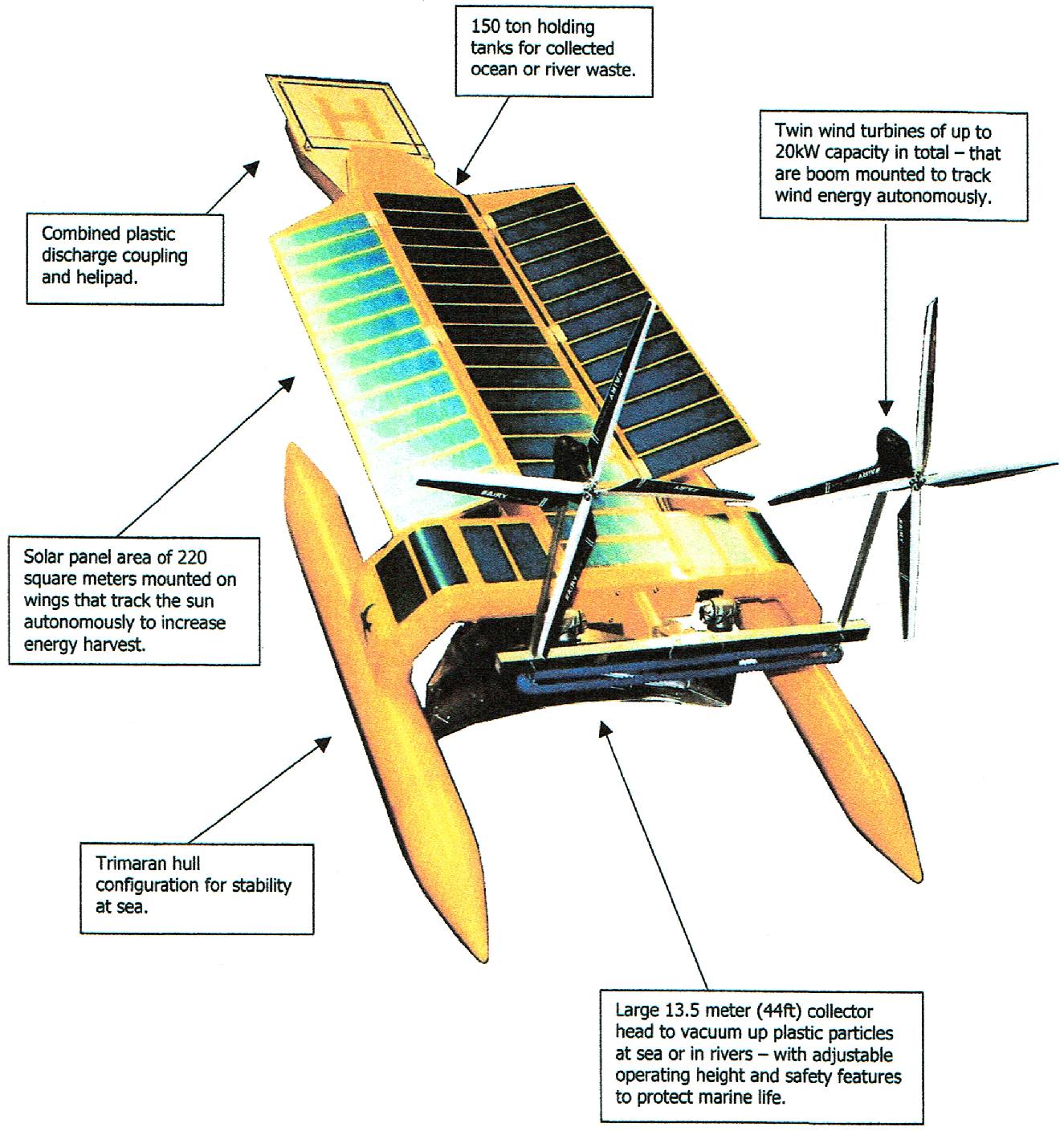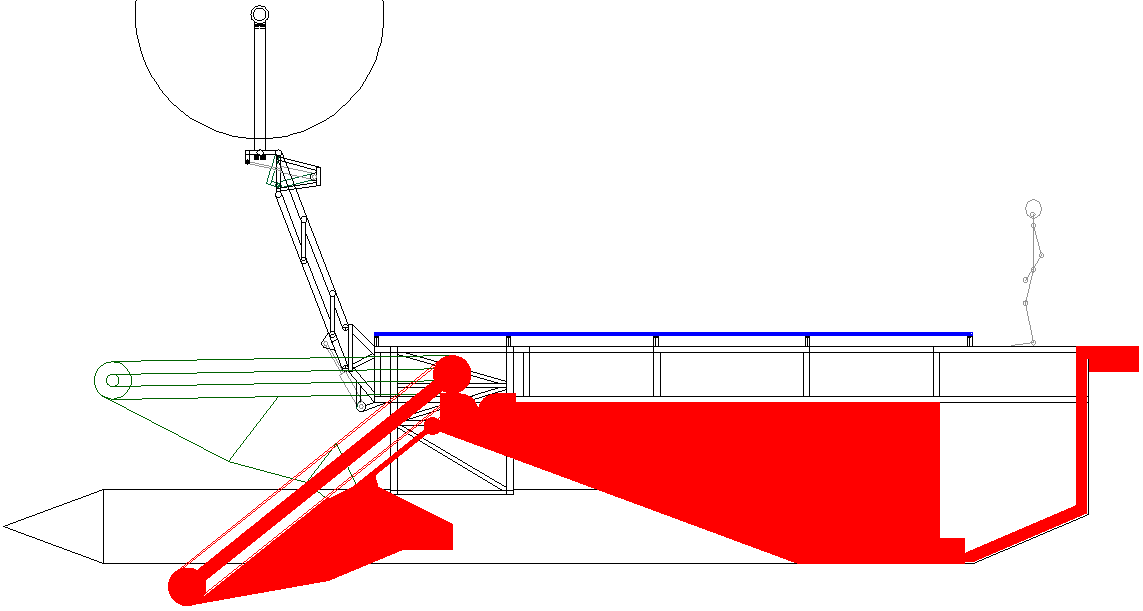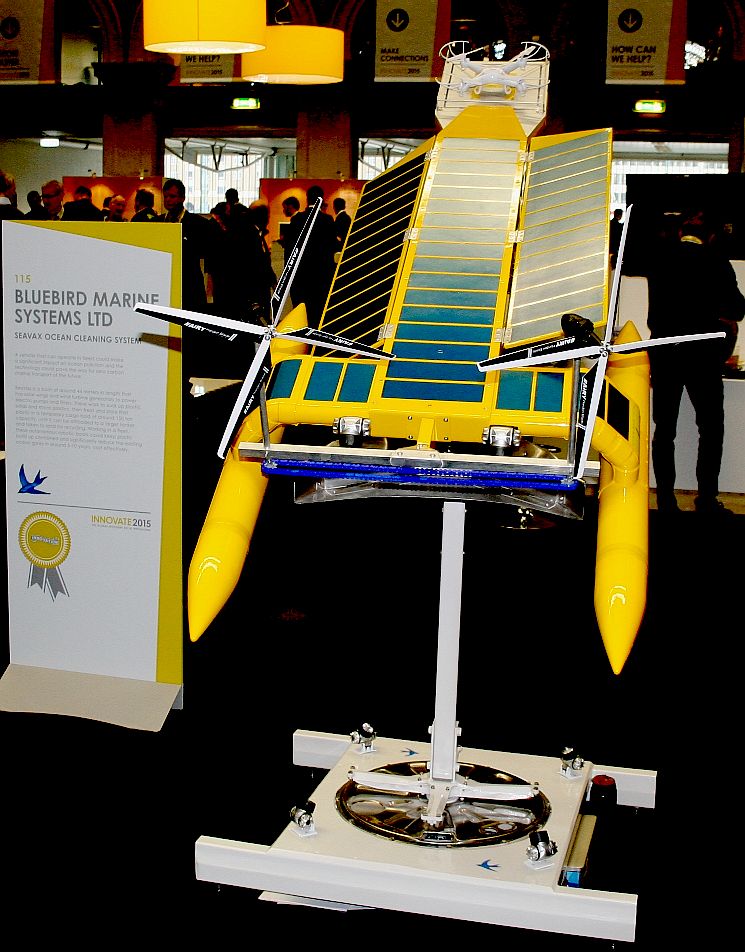|
H2020 CE-FNR-09 PLASTIC MARINE LITTER PILOT ACTION
|
|
|
H2020 WORK PROGRAMME - Pilot action for the removal of marine plastics and litter - Research Innovation Action.
The Horizon 2020 budget for this call is: €13 200 000 Euros looking for proposals in the € 6m region - hence they appear to be looking to fund two-three projects. The deadline for lodging proposals is January 22 2020, Brussels time. See the Cleaner Ocean Foundation outline proposal here.
Specific
Challenge:
Therefore, urgent action is needed both for the prevention and for the removal of existing marine litter, notably plastics and microplastics. For this topic, a demonstration of the removal of marine litter and research is being proposed, highlighting how the environment is impacted by the removal, and the corresponding impacts in terms of ecosystem and economic recovery.
Scope:
Accompanying research will have to address impacts on coastal ecosystems’ food chains, biodiversity and functioning, fisheries, aquaculture, Marine Protected Areas, wild life and local economies (all of these) 6, 12, 18 and 24 months after the (start of the) cleaning. At the end of the project, the consortium is expected to identify a way forward and lay the foundations for upscaling with a view to a future potentially automated removal of historically accumulated marine litter (legacy), in particular at hot-spots of accumulated marine litter.
The inclusion of actions to reduce other pollutants and effects of stressors is an advantage.
Projects shall demonstrate the effectiveness of an (or several) automatic or remotely controlled wireless device(s) capable of collecting plastics and other marine litter of reasonable size (larger micro-litter and macro-litter up to a meter or so).
The proposed solution must be able to work at the sea surface and on the seafloor/beach. The demonstration has to be for longer periods of time (several months on one site; several sites at the same time are acceptable). The marine litter must be sorted and reused (project must include demonstration of feeding of litter into reuse/recycling chains) in line with the circular economy and the plastics strategy. The environmental impact, notably on biota, has to be minimized and assessed.
The project must include demonstrations in different sites, including beaches, harbours and shallow seafloor.
This topic is in support of the European Strategy for Plastics in a Circular Economy. Selected projects under this topic as well as projects selected under other topics in H2020 supporting the Plastics Strategy are strongly encouraged to participate in joint activities as appropriate.
These joint activities could take the form of clustering of projects, participation in workshops, common exploitation and dissemination etc. The projects should describe how they will be complementary with already existing relevant national activities or other multilateral activities funded by the EU or funded jointly by several Member States.
The proposals are expected to demonstrate support to common coordination and dissemination activities. Therefore, the proposals should foresee a dedicated work package for this purpose and earmark appropriate resources. Further details of these coordination activities will be defined during the grant preparation phase with the Commission.
The Commission considers that proposals requesting a contribution from the EU in the range of EUR 6 million would allow this challenge to be addressed appropriately. This does not preclude the submission and selection of proposals requesting other amounts.
Expected Impact:
Contributing to the ongoing implementation of EU Policies such as the EU Bioeconomy Strategy, the Circular Economy Strategy, the European Strategy for Plastics in a Circular Economy, the European Integrated Maritime Policy, the Marine Strategy Framework Directive and the UN Sustainable Development Goals, activities will:
In the short-term:
- Support the implementation of the UN Nations Decade of Ocean Science for Sustainable Development, and the needs of the Marine Strategy Framework Directive.
- Achieve at least TRL 6.
- Achieve a removal of 90% of macro-plastic litter and a substantial fraction of micro-litter in the demonstration areas reducing the clean-up cost to the local blue economy.
- Increase availability of efficient and environmentally sustainable technologies to remove existing marine litter.
- Contribute to awareness rising of citizens about the importance of prevention to avoid environmental damage and high costs (for the community and the tax payer instead of the polluter).
- Contribute to the sustainable management and protection of marine and coastal ecosystems to avoid significant adverse impacts (UN SDG 14).
In the medium-term:
- Obtain no more damage from marine litter to the local blue-economy and marine ecosystems services.
- Achieve 80% reduction of micro-plastics in shellfish in treated areas (or other locally important small marine animals).
Increase scientific knowledge, develop research capacity and transfer marine technology, taking into account the Intergovernmental Oceanographic Commission Criteria and Guidelines on the Transfer of Marine Technology, in order to improve ocean health (UN SDG 14).
- Ensure that collected marine plastics are reused or reconverted in a way that is in line with the European Strategy for Plastics in a Circular Economy.
- Shorten the time span between research and innovation and foster economic value in the blue economy.
- Improve the professional skills and competences of those working and being trained to work within the blue economy and in the context of open data sharing.
- Increase data sharing and increase integration of data.
- Contribute to determining the distribution and fate of marine litter and microplastics.
In the long-term:
- Achieve 80% reduction of micro-plastics and plastics in non-migratory birds species in the areas where cleaning technologies are being used.
-
Achieve substantial reduction of micro-plastics originating from macro-plastics
locally.
OCEAN & RIVER CLEANER - This vessel is designed to operate in fleets to target ocean waste before it settles on the ocean floor where nobody can recover it economically. There is nothing like it in existence today.
"BE THE SOLUTION, NOT THE POLLUTION"
1. Eligible countries: described in Annex A of the Work Programme.
A
number of non-EU/non-Associated Countries that are not automatically eligible
for funding have made specific provisions for making funding available for their
participants in Horizon 2020 projects. See the information in the Online
Manual.
3.
Evaluation:
- Submission and evaluation processes are described in the Online Manual.
4.
Indicative time for evaluation and grant agreements:
5.
Proposal templates, evaluation forms and model grant agreements (MGA):
6.
Additional provisions:
7.
Open access must be granted to all scientific publications resulting from
Horizon 2020 actions.
The
Open Research Data Pilot has been extended to cover all Horizon 2020 topics for
which the submission is opened on 26 July 2016 or later. Projects funded under
this topic will therefore by default provide open access to the research data
they generate, except if they decide to opt-out under the conditions described
in Annex
L of the Work Programme. Projects can opt-out at any stage, that is both
before and after the grant signature.
8.
Additional documents:
37 ORGANIZATIONS ARE LOOKING FOR COLLABORATION PARTNERS FOR THIS TOPIC
.....
Type of Action: Innovation action [IA]
GET SUPPORT
Please read carefully all provisions below before the preparation of your application.
H2020 Online Manualis your guide on the procedures from proposal submission to managing your grant.
Funding and tenders Portal FAQ – Submission of proposals.
National Contact Points (NCP) - contact your NCP for further assistance in your national language(s).
Research Enquiry Service – ask questions about any aspect of European research in general and the EU Research Framework Programmes in particular.
Enterprise Europe Network– contact your EEN national contact for advice to businesses with special focus on SMEs. The support includes guidance on the EU research funding.
IT Helpdesk Contact the Participant Portal IT helpdesk for questions such as forgotten passwords, access rights and roles, technical aspects of submission of proposals, etc.
Ethics – for compliance with ethical issues, see the Online Manual and Science and Society Portal
Ethics
– for compliance with ethical issues, see the Online Manual and Science and
Society Portal
Partner Search Services help you find a partner organisation for your proposal.
CALL
INFORMATION
SDG 6 – Clean Water and Sanitation; SDG 8 – Inclusive and sustainable economic growth; SDG 9 – Sustainable Industrialisation; SDG 11 – Sustainable Cities and Communities; SDG 12 - Responsible Consumption and Production;
DRAFT DESIGN 2020 - The filtration module, cargo hold and offloading mechanism is shown in red in outline form. The system consists of several integrated components, incorporating motors, pumps, hydraulics, electronics and computer programs - all to be powered by energy from nature - if we are to avoid more greenhouse gas emissions. Note that this is the design for the 12 meter coastal development rig, rather than the 44 meter ocean cleaning machines. Copyright © diagram Cleaner Ocean Foundation. All rights reserved.
FUNDING RATE INNOVATION ACTIONS (IA)
D.
Types of action: specific provisions and funding rates1,2
A ‘demonstration or pilot’ aims to validate the technical and economic viability of a new or improved technology, product, process, service or solution in an operational (or near to operational) environment, whether industrial or otherwise, involving where appropriate a larger scale prototype or demonstrator.
A ‘market replication’ aims to support the first application/deployment in the market of an innovation that has already been demonstrated but not yet applied/deployed in the market due to market failures/barriers to uptake. 'Market replication' does not cover multiple applications in the market of an innovation3 that has already been applied successfully once in the market. ‘First’ means new at least to Europe or new at least to the application sector in question. Often such projects involve a validation of technical and economic performance at system level in real life operating conditions provided by the market.
Projects may include limited research and development activities.
Funding
rate: 70% (except for non-profit legal entities, where a rate of 100% applies)
REVOLVING SHOW STAND - [LEFT] October 9th: The is a progress picture of the plinth and column in our workshops, now painted in white for Innovate2015. The solar wings and wind turbine generators are not fitted during development. Click on the picture to see how we built this stand. [RIGHT] This is a picture of the display on November 10th 2015 at the Innovate 2015 event. You can see a video of this revolving on our Homepage. The solar wings and wind turbines are fitted and a UAV drone is seen on the helipad at the rear end of the boat.
Youtube ocean pollution
LINKS
https://
Anchovies | Bass | Bream | Catfish | Clams | Cod Coley | Crabs | Crayfish | Eels | Grouper | Haddock | Hake | Halibut | Herring | Jellyfish Krill | Lobster | Mackerel | Marlin | Monkfish | Mullet | Mussels | Oysters | Perch | Plaice | Pollock | Prawns | Rays | Sablefish | Salmon Sardines | Scallops | Sharks | Shrimp | Skate | Sole | Sprat | Squid | Sturgeon | Swordfish | Trout | Tuna | Turbot | Whiting
ACIDIFICATION - ADRIATIC - AEGEAN - ARCTIC - ATLANTIC - BALTIC - BAY BENGAL - BERING - CARIBBEAN - CORAL - EAST CHINA ENGLISH CH - GULF GUINEA - GULF MEXICO - INDIAN - IONIAN - IRISH - MEDITERRANEAN - NORTH SEA - PACIFIC - PERSIAN GULF - SEA JAPAN STH CHINA - PLASTIC - PLANKTON - PLASTIC OCEANS - SEA LEVEL RISE - SOUTHERN - TYRRHENIAN - UNCLOS - UNEP WOC - WWF
AMAZON - BURIGANGA - CITARUM - CONGO - CUYAHOGA - GANGES - IRTYSH - JORDAN - LENA - MANTANZA-RIACHUELO MARILAO - MEKONG - MISSISSIPPI - NIGER - NILE - PARANA - PASIG - SARNO - THAMES - YANGTZE - YAMUNA - YELLOW
ABS - BIOMAGNIFICATION - CANCER - CARRIER BAGS - CLOTHING - COTTON BUDS - DDT - FISHING NETS HEAVY METALS - MARINE LITTER - MICROBEADS - MICRO PLASTICS - NYLON - OCEAN GYRES - OCEAN WASTE PACKAGING - PCBS - PET - PETROLEUM - PLASTIC - PLASTICS - POLYCARBONATE - POLYSTYRENE - POLYPROPYLENE - POLYTHENE - POPS PVC - SHOES - SINGLE USE - SOUP - STRAWS - WATER
SEAVAX = INNOVATION - In reality progress is a battle between innovators and regulators. Innovators provide solutions to problems. Regulators present problems to solutions. There is as yet no rule book for ocean cleaning. We are will be writing a "fact" book for guidance, as we discover the best operational practices. In nature there are no rules, save for survival of the fittest. Innovation (evolution) relies on rule breakers. The picture above was of flotation and tow tank testing including solar panel deployment. Wind turbines were not needed for these trials. Note, the vessel is not fitted with the helipad at this stage.
|
|
|
This website is Copyright © 2019 Bluebird Marine Systems Ltd. The names Bluebird™, RiverVax™, SeaNet™, SeaVax™ and the manta ray fish logo are trademarks. CONTACT US The color blue is a protected feature of the trade marks.
|



